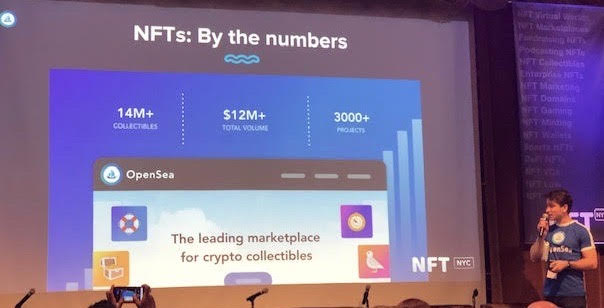Non-Fungible Tokens: A Giant Leap into Owning Our Digital Assets
Wendy Glavin, Founder & CEO, Wendy Glavin Agency
Throughout the years, I, like most parents, watched their kids grow up playing video games. I remember them playing Super Mario Bros., Madden NFL, Super Smash Bros., Call of Duty and many more, on their Xbox, Nintendo and PlayStation. Most of the which we bought at GameStop or Best Buy for $49.99- $59.99.
In 2017, a new game, Fortnite, could be downloaded for free from one’s Xbox One, PS4 or computer. The online video game developed by Epic Games, gained one million players within 24 hours. And, after launching on mobile devices, the game had roughly 250 million global players in March 2019 -- a worldwide global phenomenon.
As a researcher, I wanted to explore the game so I watched Ninja PlaysFortnite Chapter 2 Season 2. For those unfamiliar, it’s a survival competition where roughly 100 players are dropped on an island, run around using tools and weapons to build forts, hide in them, stay out of the eye of a storm and fight to win buy not getting shot.
While free, if you make in-game purchases such “skins” or outfits, weapons and other items you have to pay. The popularity is based on competition, playing with friends at-home or online and watching more experienced players to improve.
How Do Non-Fungible Tokens (NFT’s) Fit It?
When I was asked to coverNFT.NYC, the Leading Non-Fungible Token Event in New York City, I wanted to learn before attending what NFTs are.
Using Fortnite as an example, purchases are made with in-game currency called Vbucks through its in-game store. Only available for 24-hours, items become scarce, are not able to be traded, used in other games and have no liquidity. Therefore, they are fungible tokens.
Instead, using gaming based on blockchain, items are owned, authenticated, can be traded and exchanged in other gaming platforms which makes them non-fungible. Fungible comes from a Latin phrase meaning “to serve in place of” and that's what something that's fungible does: serves in place of what it's exchanged for. A common example is lending someone $20.00 which is paid back with a $10.00 bill and two $5.00 bills which is the same amount.
In contrast, when people own non-fungible tokens, they own the physical or digital item, like a virtual sword, an event ticket, redemption codes, gifts, coupons, digital art, collectibles and other assets. The ability to trade assets demonstrates the move into an open, free-market economy. With this research done, I was ready to attend NFT.
Tokenizing Attention and NFT’s for Livestreaming
The Keynote was presented by Ian Utile, CEO of ATTN.Live, as he rode back and forth across the stage on a one-wheel “motorcycle,” the size of a skateboard to illustrate his point about tokenizing attention with NFT’s through live streaming.
Content creators need data ownership and multi-platform distribution with a voice interface. Ian said, “With all the platforms, like Instagram, YouTube, Twitter, Facebook and the other sites, I need to have five cellphones to livestream which is a problem. People can’t afford to have five cellphones. We’ve solved this problem with one piece of software and a touch of a button which takes my audio live on all the platforms on any device. I like to call it live-podcasting.”
A Giant Leap into Owning Our Digital Assets
NFTs and Gaming
Jodee Rich, CEO, ofPeopleBrowser,NFT.Kred andNFT.NYC discussed NFTs and gaming. People Browser is the world’s largest social intelligence program that integrates social data, analytics and advanced network technology into NFT.Kred which creates actionable NFT’s digital tokens for events, influencers and enterprises.
While on-stage, Jodee began the discussion about blockchain-powered engagement by holding up aCryptoKitties costume and said, “If you ask a really good question you can get this.” CryptoKitties is an online game for people to breed and collect virtual kittens. Each are one-of-kind, digitally scarce, use an NFT within smart contracts, ERC #721 to make blockchain accessible to everyone. Powered by Ethereum, you need a computer, digital wallet and Ether, a digital currency.
Jodee asked for someone in the audience wearing Nike sneakers to come on-stage. In December, Nike introduced a virtual shoe or collectible called CryptoKick. Jodee explained that when you do something in real-life like run a lot, provided Nike has the data, your physical activity morphs into your virtual shoe which you see when you purchase it. There’s a bi-directional relationship where Nike’s token can be traded in marketplaces, like Open Sea.
He introduced David Boag, Founder of BOAG Law, PLLC, a boutique law practice that services the intellectual property needs of companies of all sizes and disciplines, with a focus on emerging companies in NYC’s technology sector. To learn more, please read Jodee and David’s article called,Nike’s Dec 2019 patent reveals revolutionary NFT use.
Now, back to CrytoKitties. After its success, other digital collectibles were built on the blockchain. For example, I spoke with the team atSplinterlands about the company’s cards; each of which are an NFT that can be used to battle and combat players for crypto and other prizes. As of January 17, 2020, the cards can be transferred from the game to ERC-721 tokens on the Ethereum blockchain where they can be bought, sold, and traded on theOpenSea platform.
OpenSea, the world’s largest digital marketplace for crypto collectibles, NFTs, and ERC721 and ERC115 assets, including,Gods Unchained cards,Decentraland, where you can buy a plot of land, build things on-top of it and resell it. What used to be a Virtual World, is now being treated as real assets.
To learn more about crypto and gaming, please go toCoinTelegraph’s recent article.
Cameron Bale, Co-Founder and Producer of NFT.NYC and Director of Marketing and Product Management at PeopleBrowser and Kred moderated the discussion about experimenting and minting NFTs withNate Geier, CEO ofMintbase, which mints real-world assets by you or your company on Ethereum. The panel also featured Julien Genestoux, CEO ofUnlock,Johan Unger, Co-Founder and Project Lead atMarble Cards andRyan Berkun, Founder and CEO ofFabrx Blockchain.
NFTs by the Numbers
Examples of NFT Use Cases
Julien spoke about how the attention-driven economy will be replaced by a membership-driven economy because of content overload, fake news, clickbait and more. Nowadays, people are using ad-blockers which negatively affects creators.
In December 2019, Forbes in conjunction with Unlock, is enabling people to “unlock an ad-free experience” on its site, including one for a month and another for a week. After purchasing a key and a crypto wallet, you can go to thecrypto section of forbes.com, and click on the "Unlock an ads free experience" button. Julien added, “Once the transaction has been mined, users will receive an NFT token which represents their membership. And like other NFT’s it can be transferred onto marketplaces including, Open Sea and others.”
I spoke with Ryan about Fabr(x). “In web2, (The Old Web) email is home-based and content is key. With the New Web, web3, wallets and tokens empower self-ownership.”From apps to application program interfaces (APIs) to embedding IFTTs, (“if this, then what”) another “as-a-service” that connects apps, devices and services from different developers.This network is called Stratosphere which operates on the cloud infrastructure of Amazon, Google and Microsoft.
In non-technical terms, Fabr (x) enables open financing, the tokenization of real estate assets, strengthens customer loyalty, rewards users for purchases, provides financial self-sovereignty be enabling people to control their funds.
Nate spoke about Mintbase’s offerings including, NFT (ERC-721)-enabled wallets that customers control along with their private keys. Mintbase also uses blockchain and Virtual Reality (VR) in art.CrytoVoxels, is a minting tool for creating tokens with your smart contract which can be sold or transferred to OpenSea. It also includes developer APIs and the ability to embed NFTs into websites.
The event was jam-packed with panelists, speakers, attendees and Q & A’s. Throughout the day, people used side-rooms for demos, interviews, podcasts, networking and more. To review the extensive event, please go to theprogram.
In May 2018 at Social Media Week, I was introduced to blockchain, and quickly immersed myself in the subject. At that time, I interviewed Jeffrey Lancaster from Decoded and wrote an article for Equities called,The Amazing Utility of Blockchain: From Mining Crypto for Charities to Tracking E-Coli.
At that point in time, the article was too complex for people to understand so I wrote a blockchain 101 piece called,How Blockchain Can Rebuild Digital Trust.
Terms like digital privacy, owning our data, bitcoin, Ethereum, cryptocurrency, democratization of trust, transparency and authenticity were becoming a global debate of ideas.
Some of the technology industry terms became more mainstream after Brittany Kaiser’s documentary, “The Great Hack”, was released on Netflix. Then came Facebook’s announcement of the Libra “cryptocurrency” along with J.P. Morgan’s digital coin, JPM Coin, representing a fiat currency.
On February 23, The Simpsons aired an episode called “Frinkcoin”. It’s another example of (technology) cryptocurrency entering mainstream media and society.
The NFT.NYC event brought blockchain to a new level with in-depth and engaging discussions and a wide variety of Non-Fungible Tokens use cases. Digital assets employ open-source software that is real and permanent. While speed, scalability, user experience (UX) and cost need to improve, Roham Gharegozlou, Co-Founder and CEO of CryptoKitties said, “For the first time we can transition to true digital freedom where identity, self-expression and ownership are back where they belong – in your hands.” -- TEDxVienna Talk
Wendy Glavin - Everyone is Not a Journalist – Think Before You Hit Print




